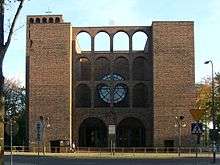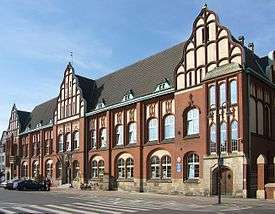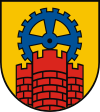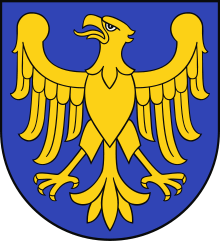Zabrze
| Zabrze | |||
|---|---|---|---|
|
Main Post Office | |||
| |||
 Zabrze | |||
| Coordinates: 50°18′N 18°47′E / 50.300°N 18.783°E | |||
| Country | Poland | ||
| Voivodeship | Silesian | ||
| County | city county | ||
| Established | thirteenth century | ||
| Town rights | 1922 | ||
| Government | |||
| • Mayor | Małgorzata Mańka-Szulik | ||
| Area | |||
| • City | 80.40 km2 (31.04 sq mi) | ||
| Population (2013) | |||
| • City | 179,452[1] | ||
| • Urban | 2,746,000 | ||
| • Metro | 4,620,624 | ||
| Time zone | CET (UTC+1) | ||
| • Summer (DST) | CEST (UTC+2) | ||
| Postal code | 41-800 to 41-820 | ||
| Area code(s) | +48 32 | ||
| Car plates | SZ | ||
| Website | um.zabrze.pl | ||
Zabrze [ˈzabʐɛ] (English: /ˈzɑːbʒeɪ/) (German: 1915–1945: Hindenburg O.S., full form: Hindenburg in Oberschlesien, 1905–1915: Zabrze, Silesian: Zobrze) is a city in Silesia in southern Poland, near Katowice. The west district of the Silesian Metropolis, a metropolis with a population of around 2 million. It is located in the Silesian Highlands, on the Bytomka River, a tributary of the Oder.
Zabrze is situated in the Silesian Voivodeship which was reformulated in 1999. Prior to 1999 it was situated in Katowice Voivodeship. It is one of the cities composing the 2.7 million inhabitant conurbation referred to as the Katowice urban area, itself a major centre in the greater Silesian metropolitan area which is populated by just over five million people.[2] The population of Zabrze as of June 2009, is 188,122.[3]
History

Early history
Biskupice (Biskupitz), which is now a subdivision of Zabrze, was first mentioned in 1243 as Biscupici dicitur cirka Bitom. Alt-Zabrze was mentioned in 1295-1305 as Sadbre sive Cunczindorf (sive = or). In the Late Middle Ages, the local Silesian Piast dukes invited German settlers into the territory resulting in increasing German settlement. Zabrze became part of the Habsburg Monarchy of Austria in 1526, and was later annexed by the Kingdom of Prussia during the Silesian Wars. In 1774, the Dorotheendorf settlement was founded. When the first mine in Zabrze became operational in 1790, the town became an important mining center.
Early twentieth century
In 1905, the Zabrze commune was formed by the former communes Alt-Zabrze, Klein-Zabrze and Dorotheendorf. The Zabrze commune was renamed Hindenburg in 1915 in honour of Generalfeldmarschall Paul von Hindenburg. The name change was approved by King Wilhelm II on 21 February 1915.[4] During the plebiscite held after World War I, 21,333 inhabitants (59%) of the Hindenburg commune voted to remain in Germany, while 14,873 (41%) voted for incorporation to Poland.[4] In May 1921 the Third Silesian Uprising broke out and Hindenburg was captured by Polish insurgents, who held it until the end of the uprising.[4] When Upper Silesia was divided between Poland and Germany in 1921, the Hindenburg commune remained in Germany. It received its city charter in 1922. Just five years after founding Hindenburg became the biggest city in German Upper Silesia and the second biggest City in German Silesia after Breslau. In the March 1933 elections, most of the citizens voted for Nazi Party, followed by Zentrum and the Communist Party. Nazi politician Max Fillusch became the city's mayor and remained in the position until 1945.[5]
World War Two and aftermath
The town's synagogue, that had stood since 1872, was destroyed in the Kristallnacht pogroms of November 1938.[6] Following World War II, the city was assigned to Poland in 1945 and was renamed back to Zabrze on May 19, 1945. Most of the German inhabitants were expelled.
Administrative divisions
Districts and housing estates
On the 17th September 2012, the Zabrze city council decided on a new administrative division of the city. Zabrze was subsequently divided into 15 districts and 3 housing estates.[7]
Districts

|
|
Infrastructure
The polish A4, which is part of the European E40, has a motorway junction near Zabrze. The Drogowa Trasa Srednicowa leads through the town.
Politics
Members of Parliament (Sejm) elected from Bytom/Gliwice/Zabrze constituency
- Chojnacki Jan, SLD-UP
- Dulias Stanisław, Samoobrona
- Gałażewski Andrzej, PO
- Janik Ewa, SLD-UP
- Kubica Józef, SLD-UP
- Martyniuk Wacław, SLD-UP
- Okoński Wiesław, SLD-UP
- Szarama Wojciech, PiS
- Szumilas Krystyna, PO
- Widuch Marek, SLD-UP
Sport
- Górnik Zabrze - men's football team (Polish Champion 1957, 1959, 1961, 1963, 1964, 1965, 1966, 1967, 1971, 1972, 1985, 1986, 1987, 1988; Polish Cup winner 1965, 1968, 1969, 1970, 1971, 1972; Polish Supercup winner 1988)
- Wojtek Wolski - Pro ice hockey player for the Washington Capitals of the National Hockey League
Economy
Like other towns in this populous region, it is an important manufacturing centre, having coal-mines, iron, wire, glass, chemical and oil works, and local Upper Silesia Brewery, etc.
Notable people
- Karl Godulla (1781–1848), Prussian industrialist
- James Kleist (1873-1949), German-American Jesuit scholar
- Heinz Fiebig (1897–1964), Wehrmacht general
- Wolfgang Jörchel (1907–1945), Standartenführer in the Waffen SS
- Fritz Laband (1925–1982), German footballer
- Friedrich Nowottny (born 1929), German television journalist
- Janosch (born 1931), German author
- Joachim Kroll (1933–1991), German serial killer
- Joachim Kerzel (born 1941), German actor
- Wojtek Wolski, Canadian/Polish hockey player playing for the Washington Capitals of the NHL, was born here in 1986.
- Krystian Zimerman, internationally renowned classical pianist, was born here in 1956.
- Władysław Józef Marian Turowicz, Polish Pakistani military scientist
- Jan Sawka, Polish/American artist, architect
- Waldemar Sorychta, heavy metal musician and producer
- The Dumplings, electropop band[8]
International relations
Twin towns — Sister cities
Zabrze is twinned with these cities:
References
- Notes
- ↑ Rocznik Demograficzny 2012
- ↑ European Spatial Planning Observation Network (ESPON)
- ↑ Central Statistical Office, Warsaw 2009, "Population. Size and Structure by Territorial Division, as of June 30, 2009" (PDF). Retrieved 2009-12-31.
- 1 2 3 Historia - Hindenburg at the official website of Zabrze
- ↑ Stadtkreis Zabrze at Geschichte on Demand website
- ↑ Ghetto Fighters' House archives, Photo No. 55805: a memorial monument placed by the Zabrze municipality in 1998 to commemorate its Jewish community.
- ↑ Zestawienie liczby mieszkańców z uwzględnieniem podziału na dzielnice na dzień: 30-09-2013.
- ↑ "The Dumplings — Free listening, videos, concerts, stats and photos at Last.fm". www.last.fm. Retrieved 2016-05-19.
External links
| Wikimedia Commons has media related to Zabrze. |
- Municipal website (Polish)
- Zabrze Community (Polish)
- Portal Zabrze.com.pl (Polish)
- Encyclopædia Britannica Zabrze
- Jewish Community in Zabrze on Virtual Shtetl
- Old images of the city (German)
- http://www.zabrze.aplus.pl/
Coordinates: 50°18′N 18°47′E / 50.300°N 18.783°E



